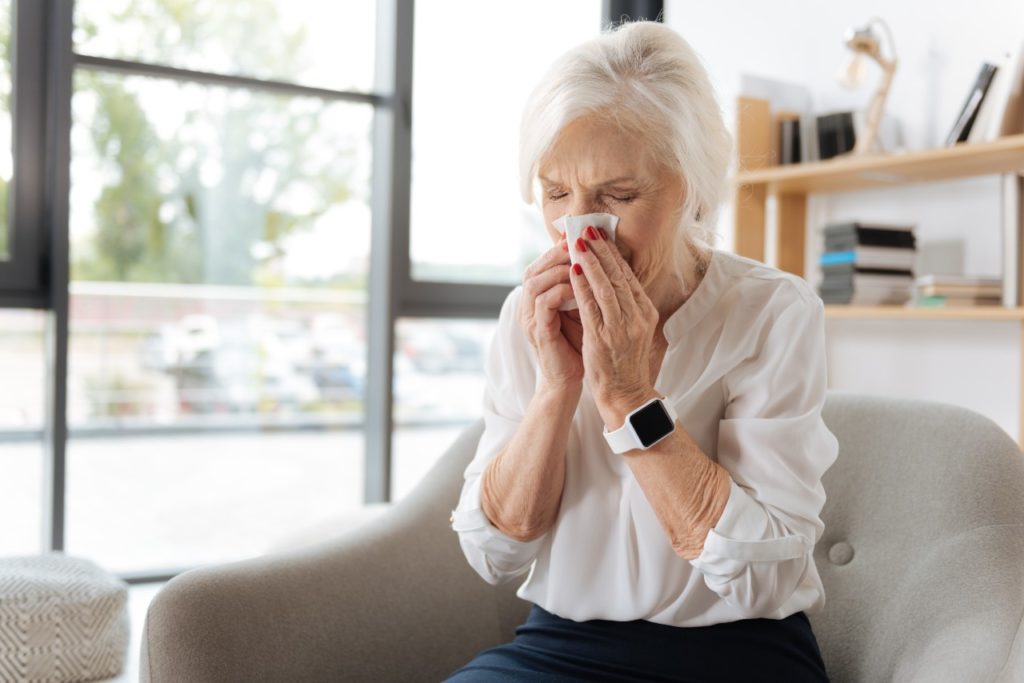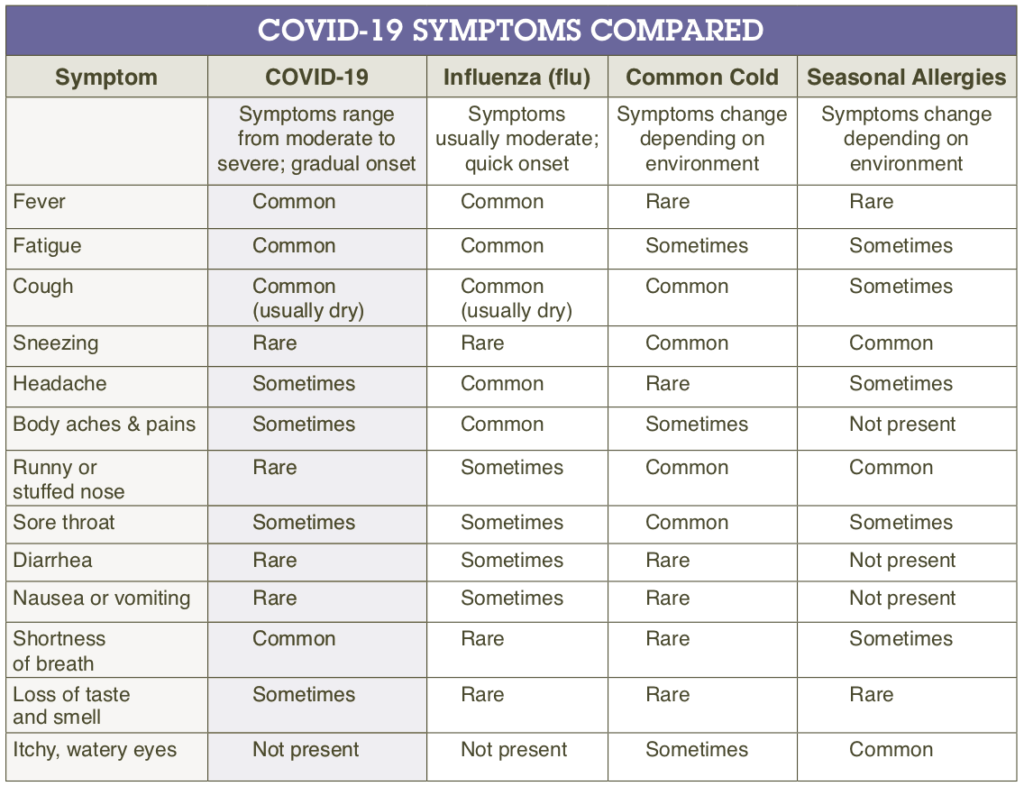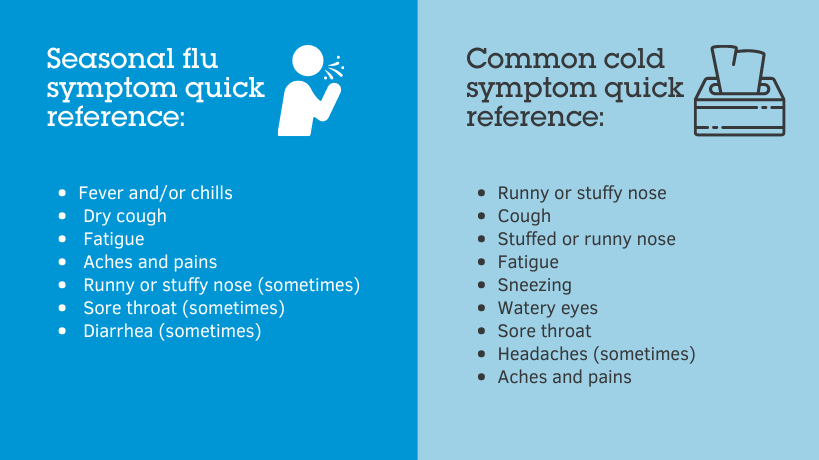Do I have a cold, the flu or
COVID-19?
in
COVID - 19 News
Written by PARC Retirement Living

A ticklish throat, a stuffy nose, a burning forehead: right now, almost any hint of oncoming illness feels alarming. With COVID-19 cases on the rise and flu season fast approaching, it’s more important than ever to know the difference between COVID-19 symptoms and those of the garden-variety flu or head cold – and what to do depending on how you feel.
Know the symptoms of COVID-19
Since the flu and COVID-19 are both respiratory illnesses, it can be difficult to tell the difference at first. Both have the potential to make you feel very sick, and both present extra risks to seniors and those with underlying health conditions.
The most commonly reported symptoms of those with COVID-19 are fever, dry cough and fatigue. Other symptoms that are less common, but still affect some patients, include: aches and pains, nasal congestion, headache, sore throat and loss of taste or smell. In most cases, COVID-19 symptoms are mild and begin gradually, appearing within five days after exposure – but it can take up to 14 days.
COVID-19 symptom quick reference:
- Fever and/or chills
- Dry cough
- Difficulty breathing
- Fatigue
- Aches and pains
- Loss of smell and taste (sometimes)
- Headaches (sometimes)
- Sore throat (sometimes)
If you have any symptoms of illness: The B.C. Centre for Disease Control isn’t taking any chances, and offers this handy online tool for COVID-19 self-assessment. Depending on the severity and nature of your symptoms, the tool will direct you to the emergency room, to a COVID-19 testing facility or to your family doctor for a consultation. Or, it will simply recommend that you stay home and self-isolate (stay away from other people completely).
*When to seek help immediately: Anyone experiencing severe difficulty breathing (struggling to breathe or only able to speak in single words), severe chest pain, having a very hard time waking up, feeling confused or losing consciousness should call 9-1-1 or go directly to the nearest hospital emergency department.
Prevention and treatment. Since there is currently no widely available vaccine or treatment for COVID-19, prevention is your best bet. Social distancing is the key: maintain a distance of two metres from other people as much as possible, avoid crowded areas and indoor public spaces and wash your hands frequently. If you must visit an indoor space where it’s difficult to keep your distance – such as a grocery store or mall – wear a non-medical face mask or other face covering (they’re now required in many public spaces anyway, including on public transit). While the data shows that most people who test positive for COVID-19 (around 80 per cent) will recover without needing hospital treatment, older adults and individuals with underlying medical issues such as diabetes, lung problems and high blood pressure run a greater risk from exposure.
If you test positive for COVID-19 and your symptoms or mild, your doctor will likely tell you to stay home, get plenty of rest and fluids and take the usual steps to boost your immune system, such as eating nutritious foods, until your body clears the virus and you test negative. More severe cases may require hospital treatment and administration of oxygen.

How colds and flu are different than COVID-19
Both the flu and COVID-19 are respiratory ailments brought on by viruses. COVID-19 is caused by the novel coronavirus SARS-CoV-2, while the flu, or seasonal influenza, results from infection by any number of influenza viruses.
Flu symptoms typically come on quickly, unlike those of COVID-19, and last for five to seven days. Colds are caused by a variety of viruses and also tend to come on quickly, lasting for a week to 10 days. The common cold tends to be milder than the flu, bringing a stuffed-up nose and sneezing – usually without fever or headaches.

Prevention and treatment: While there is no known cure for the common cold or the flu, seasonal influenza vaccines are available in B.C. each year, and should be the first line of defence for those who are most vulnerable to complications, like seniors.
Over-the-counter medications can help manage cold and flu symptoms, but as most doctors will tell you, the best treatments are rest, hydration and nutrition – to help your immune system do its job. Given time, a healthy body will clear most cold and flu viruses without medical intervention.
To learn more, or for additional help with identifying respiratory illnesses, Harvard Medical School recently published an in-depth article comparing symptoms. The American Center for Disease Control also offers a guide for comparing ailments and different types of respiratory symptoms, and the World Health Organization answers the most frequently asked questions about COVID-19.
At PARC Retirement Living, we’re vigilant about illness. Our staff and residents truly care about one other, and always alert our onsite wellness nurses to any symptoms of colds, flus or other ailments. We’re happy to say that, thanks to our system of safety protocols and health supports, all PARC residences have remained COVID-free since the start of the pandemic.

